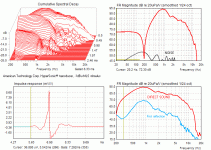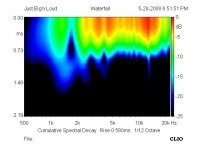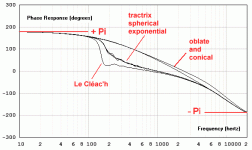soongsc said:
Puting it this way, I think I'm getting a better feeling why one would want controlled directivity instead of dipole or omni-directional. With a well controlled roll-off from on-axis to way off-axis, the energy of early reflections are lower.
That is exactly correct.
ZilchLab said:
Grilles and perf screens in the path are certainly elements for analysis.
The whole room treatment thing is a recipe for madness, in my book; I'd prefer not to have to build a room that "works" and be tweaking that for the rest of my life because it doesn't.
Constant directivity tips the odds in my favor....
Sure CD does this, but I truely believe that a room that is not optimized for sound reproduction will never compete with one that is. So at some point talking about how to improve speakers makes no sense if the room is lousy and left alone.
I have made a lot of measurements of screens and curtains. Commercial "acoustical screens" are terrible and I mean really bad. About 75% of the incident energy is reflected back (frequency dependent of course). Thats why my screen is a bed sheet. A 250 count pure white bed sheet has about a 1-2 dB loss at 10 kHz and an imeasureable loss below a few kHz. I opt for the bed sheet because the loss is video quality is more than made up for in better sound quality. No one, and I repeat, no one has ever detected my bed sheet, and I've had "self proclaimed" video gurus see it. They didn't believe it when I showed them. The biggest problem with the bed sheet is light transmission, which reduces the contrast because of the light from behind the screen. Flat black paint helps.
ZilchLab said:
That's the WAF thing.
Both your and my systems could use a bit of that.
Bling is sometimes a workable alternative.... 😛
I've used curtains and not. It depends on the siituation. In my HT I use them because the speakers are partially behind the screen so looking at 1/2 a speaker would not be too cool. And the screen should be surrounded in black. It improves the visual contrast. But as stated, in my living room I don't use a screen. acoustically it makes no difference either way. So if you DO have a WAF then use a screen. What sense does it make to buy crummy loudspeakers that look good in order to please your wife when you could buy good ones and just hide them so the wife won't care. Its just logic.
Post script on curtains. The screen is a dense weave - has to be for the projector, but the curtains are a very loose weave. It is hard to measure there effect, its basically nil.
One usually has to give up something to get something else. In your case, Earl, youre trading image brightness (and maybe color balance) for SQ. Not a bad trade.
But that cotton screen does have some advantages. No moire pattern from the micro-perf screen and a nice wide viewing angle.
FWIW, I spent many years as a projectionist. Film, CRT, LCD, DLP.
But that cotton screen does have some advantages. No moire pattern from the micro-perf screen and a nice wide viewing angle.
FWIW, I spent many years as a projectionist. Film, CRT, LCD, DLP.
Just in case. A high directivity ultrasonic transducer to compare with a waveguide, 10deg offaxis:
http://www.atcsd.com/site/content/view/34/47/
Another "massless" speaker?
http://www.atcsd.com/site/content/view/34/47/
Another "massless" speaker?
Attachments
gedlee said:
This is not stricktly true, it is illegal to "build, have built or otherwise assemble" no matter who you are. Its just very difficult to catch you. However, and I know this first hand, if you post how to easily infringe a patent, like you just did, then you could be guilty of "inducing to infringe" which is also a crime. Bose tried to get me on that law.
SY said:
Legally it does. You can build one to experiment with, but if you build a couple to use for music listening, you're infringing.
soongsc said:
I would assume reasonable use for educational purposes takes care of that.
Actually, in most (all?) countries, a use is required to be commercial (or to have a commercial purpose) to constitute a patent infringement.
So building any number of patented things for your own use (or for educational purposes) isn't infringing unless you then sell them and make money from it.
Ian
Your screen setup interests me. How far is it from the back wall?gedlee said:
Sure CD does this, but I truely believe that a room that is not optimized for sound reproduction will never compete with one that is. So at some point talking about how to improve speakers makes no sense if the room is lousy and left alone.
I have made a lot of measurements of screens and curtains. Commercial "acoustical screens" are terrible and I mean really bad. About 75% of the incident energy is reflected back (frequency dependent of course). Thats why my screen is a bed sheet. A 250 count pure white bed sheet has about a 1-2 dB loss at 10 kHz and an imeasureable loss below a few kHz. I opt for the bed sheet because the loss is video quality is more than made up for in better sound quality. No one, and I repeat, no one has ever detected my bed sheet, and I've had "self proclaimed" video gurus see it. They didn't believe it when I showed them. The biggest problem with the bed sheet is light transmission, which reduces the contrast because of the light from behind the screen. Flat black paint helps.
soongsc said:
Your screen setup interests me. How far is it from the back wall?
About three feet (one meter).
iand said:
Actually, in most (all?) countries, a use is required to be commercial (or to have a commercial purpose) to constitute a patent infringement.
So building any number of patented things for your own use (or for educational purposes) isn't infringing unless you then sell them and make money from it.
Ian
simply wrong in USA:
TITLE 35 > PART III > CHAPTER 28 > § 271Prev | Next § 271. Infringement of patent
(a) Except as otherwise provided in this title, whoever without authority makes, uses, offers to sell, or sells any patented invention, within the United States or imports into the United States any patented invention during the term of the patent therefor, infringes the patent.
http://www.law.cornell.edu/uscode/35/271.html
The main initial purpose of creating a patent system was to inspire innovation. If one looks at this term alone, it is impossible to even site other patents because that means previous patents are being used to develop the new patent. Which further means the new patent inventor must break the law to file a patent. This is totally wrong.jcx said:
simply wrong in USA:
TITLE 35 > PART III > CHAPTER 28 > ?271Prev | Next ?271. Infringement of patent
(a) Except as otherwise provided in this title, whoever without authority makes, uses, offers to sell, or sells any patented invention, within the United States or imports into the United States any patented invention during the term of the patent therefor, infringes the patent.
http://www.law.cornell.edu/uscode/35/271.html
gedlee said:
About three feet (one meter).
OT a bit, but how do you put the projector to let the projection come from the back?
Hello Earl,
I did yesterday evening few simulation: first a 10cm diaphragm diameter compression driver (compression ratio from 3 to 10 were used ) mounted on a Le Cléac'h flare horn then a Lowther PM2 mounted on an open baffle or in a closed enclosure.
In every case at 200Hz (a frequency at which the horn should be disadvantaged because the proximity of cut-off) for the same SPL I obtained a diaphragm dispalcement several times lower for the compression driver than for the Lowther.
Best regards from Paris, France
Jean-Michel Le CLéac'h
I did yesterday evening few simulation: first a 10cm diaphragm diameter compression driver (compression ratio from 3 to 10 were used ) mounted on a Le Cléac'h flare horn then a Lowther PM2 mounted on an open baffle or in a closed enclosure.
In every case at 200Hz (a frequency at which the horn should be disadvantaged because the proximity of cut-off) for the same SPL I obtained a diaphragm dispalcement several times lower for the compression driver than for the Lowther.
Best regards from Paris, France
Jean-Michel Le CLéac'h
gedlee said:
I didn't disregard your question, I told you why it was not important to me.
There "may be" a way to lower the directivity control, but that would necesitate an ill advised compromise in something else. As you stated yourself:
However I would strongly disagree with your last sentence as it is completely incorrect. A compression driver forced down to 160 Hz will have a huge excursion and lots of distortion while a larger piston source is operating in its region of minimum distortion. So if the directivity is the same but the piston source has lower distortion it would seem to me that even you would be using a piston source in the range of 200 Hz - 800 Hz.
And your numbers for off axis falloff are completely wrong. The response of my designs are down by about 10 dB at 45° or about 1 dB / 5° not the ridiculous 5 dB / 5° that you quoted. (see www.ai-audio.com) It's very difficult to have a decent discussion when you use data that is so far from reality.
Why don't you publish some full system polars of your systems so we can all see how well they work?
Its easy (and kind of pointless) to make statements like"
and show some pictures. But where is the data? The real proof of what you are saying? I have data and I have reviews to support my position.
Hello,
The shape of the leading part of the pulse response of an equalized driver mounted on a horn (or a waveguide) is related to the high frequencies content of the response.
Two things are important to consider: the relative level of those high frequencies versus the lower frequencies of the response and also their relative group delay.
Generally speaking high frequencies are the first to arrive but the shape of the leading edge depends on their relative level and relative group delay to the other frequency content.
Phase should be also important to consider too because for every duct (cylindrical... conical, exponential...) phase varies between an asymptot at +Pi at 0Hz and an asymptot at -Pi at very large frequency (this means that HF varies progressively , more or less quickly, to become out of phase with medium frequency. (see attached graph for unequalized drivers on different horns and waveguide)
Best regards from Paris, France
Jean-Michel Le Cléac'h
The shape of the leading part of the pulse response of an equalized driver mounted on a horn (or a waveguide) is related to the high frequencies content of the response.
Two things are important to consider: the relative level of those high frequencies versus the lower frequencies of the response and also their relative group delay.
Generally speaking high frequencies are the first to arrive but the shape of the leading edge depends on their relative level and relative group delay to the other frequency content.
Phase should be also important to consider too because for every duct (cylindrical... conical, exponential...) phase varies between an asymptot at +Pi at 0Hz and an asymptot at -Pi at very large frequency (this means that HF varies progressively , more or less quickly, to become out of phase with medium frequency. (see attached graph for unequalized drivers on different horns and waveguide)
Best regards from Paris, France
Jean-Michel Le Cléac'h
soongsc said:
Well, I'm talking about the leading part of the impulse. If it's caused by the compresson driver, then that is what needs to be fixed. Gedlee had mentioned the criticality of thoat matching, I think that would also be very difficult to solve when matching direct radiating drivers to a thoat.
Attachments
soongsc said:The main initial purpose of creating a patent system was to inspire innovation. If one looks at this term alone, it is impossible to even site other patents because that means previous patents are being used to develop the new patent. Which further means the new patent inventor must break the law to file a patent. This is totally wrong.
You are right, that is totally wrong. The law forbids unauthorized use of a patented invention. It does not forbid unauthorized use of a patent itself. You can study and reference the patent document; but without authorization from the patent holder, you can't make, use, offer to sell, or sell the invention that the patent document describes.
Jmmlc said:Hello Earl,
I did yesterday evening few simulation: first a 10cm diaphragm diameter compression driver (compression ratio from 3 to 10 were used ) mounted on a Le Cléac'h flare horn then a Lowther PM2 mounted on an open baffle or in a closed enclosure.
In every case at 200Hz (a frequency at which the horn should be disadvantaged because the proximity of cut-off) for the same SPL I obtained a diaphragm dispalcement several times lower for the compression driver than for the Lowther.
Best regards from Paris, France
Jean-Michel Le CLéac'h
That is beside the point. Piston drivers are designed for this larger excursion and compression drivers are not. One CAN design a compression driver to handle the increased excursion requirements that 200 Hz would require, but this will necessitate modifications that will seriuosly limit its HF capability. It is not viable to make a compression driver operate over two decades, unless such a device is made extremely inefficient. One decade is reasonable and effective, but two is simply not viable.
If we accept the one decade limit then it seems to me that using the compression driver over the top decade makes the most sense. Hence 80-1000 up to just over 10kHz - juat as I do - seems the correct approach. Now one could make a waveguide from 100-200 Hz to 1 kHz, but as you yourself admit the directivity would be the same for this device - which would be huge by the way, as it would be for a piston source. The piston source is very low distortion in this frequency region especially if it is large, which it should be to match the waveguides polar pattern at the crossover. So a 12" or 15" driver seems ideal - no coincidence here. Since multiple subs are clearly the way to go in small rooms (the target here) it is not necessary to push the mains woofer down very low - let the subs do it, which allows for a smaller box and lower distortion from this device.
I fail to see how a waveguide below 800 Hz offers anything.
- Status
- Not open for further replies.
- Home
- Loudspeakers
- Multi-Way
- Horn vs. Waveguide



